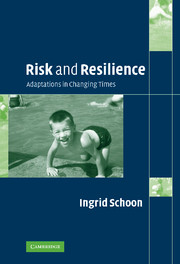Book contents
- Frontmatter
- Contents
- List of figures
- List of tables
- Foreword by Glen H. Elder, Jr
- Preface by John Bynner
- Acknowledgements
- Introduction
- 1 Risk and resilience: definitions
- 2 Towards a developmental-contextual systems model of adjustment
- 3 Persisting inequalities in times of social change
- 4 Selection, causation and cumulative risk effects
- 5 Protective factors and processes
- 6 Stability of early adjustment over time
- 7 Personal goals and life plans
- 8 Conclusions and outlook
- 9 Implications of findings for interventions and social policy
- Appendix A Two British birth cohorts
- Appendix B Response rates and handling of missing data
- Appendix C Description of variables used in the study
- References
- Index
Foreword by Glen H. Elder, Jr
Published online by Cambridge University Press: 22 September 2009
- Frontmatter
- Contents
- List of figures
- List of tables
- Foreword by Glen H. Elder, Jr
- Preface by John Bynner
- Acknowledgements
- Introduction
- 1 Risk and resilience: definitions
- 2 Towards a developmental-contextual systems model of adjustment
- 3 Persisting inequalities in times of social change
- 4 Selection, causation and cumulative risk effects
- 5 Protective factors and processes
- 6 Stability of early adjustment over time
- 7 Personal goals and life plans
- 8 Conclusions and outlook
- 9 Implications of findings for interventions and social policy
- Appendix A Two British birth cohorts
- Appendix B Response rates and handling of missing data
- Appendix C Description of variables used in the study
- References
- Index
Summary
Over the past half century, a contextual view of human lives has emerged in the social and behavioural sciences. This perspective represents a major shift in orientation from age-specific domains, such as adolescence and young adulthood, to the full life course of human careers and development. Questions relate the developing organism to lived experience in a changing world. Distinctive of this change is the evolution of life-course theory and methods, the integration of biological models, and the rapid growth of longitudinal studies and their data archives. Few books better reflect these advances than Schoon's Risk and Resilience: Adaptations in Changing Times – an illuminating study of the life course, from birth to middle age, in two British birth cohorts. The two cohorts are distinguished by people who were born at different times.
In important respects, the framework of this project dates back to the longitudinal studies of Americans born in the 1920s. These studies generated fresh thinking about the life course by following study members into the Great Depression, World War II and the postwar era. The developmental effects of each life trajectory depended on whether they were marked by hardship, military service or higher education. Over the years a set of principles have come to define the life course framework which informs Schoon's study, life-long development, human agency, the timing of events, linked lives and historical context. The life course consists of age-graded trajectories and their life transitions, involving work and family, along with other domains.
- Type
- Chapter
- Information
- Risk and ResilienceAdaptations in Changing Times, pp. xiii - xviPublisher: Cambridge University PressPrint publication year: 2006



